US headline durable goods orders rose 2.7% to USD 258.5B in March, much stronger than expectation of 0.7%. Ex-trans orders rose 0.4%, also better than expectation of 0.2% . Ex-defense orders rose 2.3%. Transportation equipment rose 7.0% to USD 93.8B.
Fed Beige Book: Effect of tariffs not to be felt for a few months
Fed’s Beige Book economic report noted that economy expanded at a “modest pace” through the end of August”. Concerns regarding tariffs and trade policy uncertainty continued. But businesses remained “optimistic” about the near-term outlook.
Overall, districts indicated that employment grew at a “modest pace”, “on par” with previous period. However, manufacturing was “flat to down” and “tightness” continued to “contrain growth” in overall business activity. Wage growth remained “modest to moderate”. There was “strong upward pressure” on pay for entry-level and low-skill workers, technology, construction, and some professional services positions.
There were “modest price increases”. Retailers and manufacturers reported “slight increases in input costs”. Firms in some districts “noted an ability to pass along price increases”. But manufacturers relayed limited ability to raise prices. Impact of tariffs on pricing were “mixed” and some districts expected effects not to be felt for a few months.
Eurozone Sentix investor confidence improved to -11.1, but economy not far from recession
Eurozone Sentix Investor Confidence improved to -11.1 in September, up from -13.7 and beat expectation of -16.0. Expectations Index improved notably from -20.0 to -12.8. However, Current Situation Index declined for the fourth month in a row, from -7.3 to -9.5, hitting the lowest level since January 2015.
The Current Situation Index shows that “Eurozone is not far from a recession”, as noted by Sentix, as they expected a recession from -10 points. Sentix added: “It is also questionable whether a recession can be avoided. For even if the expected values have improved significantly to -12.8 points, they still bear a negative sign. A sustained turnaround would require positive expectations.”
Sentix also said, “Investors are focusing on two issues here: firstly, the trade dispute between the USA and China. After the bad experiences with US President Trump’s tweets, however, hardly anyone is prepared to make an advance payment here. What remains is the ECB, from which investors expect real wonders at the forthcoming meeting. The sentix barometer for central bank policy is +30 points. So, the expectations of Mario Draghi to deliver something big and effective are high. We’ll see if he can deliver. For the financial markets, but even more for the real economy.”
Fed doubles tapering speech, 12 members project 3 hikes or more in 2022
Fed kept federal funds rate target unchanged at 0-0.25%. And, “in light of inflation developments and the further improvement in the labor market”, Fed will now reduce monthly purchases of of treasury securities and MBS at a faster rate of USD 20B and USD 10B respectively. That is, the tapering speed is doubled.
In the new median economic projections for 2022:
- GDP growth forecast was raised from 3.8% to 4.0%.
- Unemployment forecast was lowered from 3.8% to 3.5%.
- PCE inflation forecast was raised from 2.2% to 2.6%.
- Core PCE inflation forecast was raised from 2.3% to 2.7%
- Federal funds rate forecast was raised from 0.3% to 0.9%.
In the new dot plot:
- All members project one rate hike or more in 2022.
- 5 members project two rate hikes in 2022.
- 12 members project three hikes or more in 2022.
Fed Clarida: US expansion could become longest in in history in 2019
Fed Vice Chair Richard Clarida said in a speech that the US economic fundamentals are “robust”. And if the economic expansion continues in 2019 as he expected, “this will become the longest US expansion in recorded history”.
And, at this stage of the interest rate cycle, it will be “especially important to monitor a wide range of data” for the path of Fed’s policy interest rates. “Data dependence” should play in two distinct roles of “formulation and commination” of monetary policy.
He also noted that “as the economy has moved to a neighborhood consistent with the Fed’s dual-mandate objectives, risks have become more symmetric and less skewed to the downside”.
Fed Mester: Will take quite some time for activity and jobs to approach normal
Cleveland Fed President Loretta Mester said in a speech yesterday that she expected to see “an improvement in the second half of the year as the economy reopens”. However, “it will take quite some time for economic activity and job levels to approach more normal levels”. The improvements will also “vary across sectors”. Some industries like travel and leisure and hospitality will “take quite a while longer “.
By the end of 2020, the output level will see be about 6% below its level at the end of last year. Unemployment would be around (% while inflation will remain below the 2% goal “for some time to come”.
She added that it “makes sense” to continue to monitor the economy and to “to remember that there are several different scenarios that could play out, and to stand ready to use all of our tools to mitigate lasting damage and to support the economy’s recovery”
Fed Bullard: Continuing to see interest rate near zero through 2023
St. Louis Fed President James Bullard said yesterday that right now “it is looking good” as “we are coming to the end of the war here” with the pandemic. He forecast US GDP to grow 6.5% this year, while unemployment rate will fall to 4.5%. He also expects inflation to climb to 2.5%.
But, “I’d like to see actual data come in that verifies this forecast and verifies the idea that it’s going to be a very strong year for the U.S. economy,” he added. “We are still in a crisis. It could go the wrong way. So we really want to get the pandemic behind us before we start contemplating changes.”
‘I am continuing to see us near zero (on interest rate) through 2023,” Bullard said.
Fed Powell: Higher ultimate rate, ready to hike faster, no premature loosening
Dollar soars on hawkish comments from Fed Chair Jerome Powell. He indicated that ultimate level of interests is “likely to be higher than previously anticipated”. Fed is also “prepared to increase the pace of rate hikes”. He also warned against “prematurely loosening policy.
“The latest economic data have come in stronger than expected, which suggests that the ultimate level of interest rates is likely to be higher than previously anticipated,” Powell said in the prepared remarks for the semi-annual testimony to Congress.
Additionally, “if the totality of the data were to indicate that faster tightening is warranted, we would be prepared to increase the pace of rate hikes,” he added.
“Our overarching focus is using our tools to bring inflation back down to our 2 percent goal and to keep longer-term inflation expectations well anchored,” Powell emphasized. “Restoring price stability is essential to set the stage for achieving maximum employment and stable prices over the longer run.”
“The historical record cautions strongly against prematurely loosening policy. We will stay the course until the job is done,” he said.
661 US Companies and Associations urged Trump to avoid tariff escalation
In an open letter to Trump, 661 US Companies and Associations urged the administration to avoid tariff escalation with China. Instead, the administration should try to reach resolution with China on trade. The letter came as US Trade Representative is set to start hearings regarding 25% tariffs on USD 300B, essentially all untaxed, Chinese imports. The letter, lead by “Tariffs Hurt the Heartland” campaign,w as signed by 520 companies and 141 trade associations. .
“We remain concerned about the escalation of tit-for-tat tariffs,” the letter states. “We know firsthand that the additional tariffs will have a significant, negative and long-term impact on American businesses, farmers, families and the U.S. economy. Broadly applied tariffs are not an effective tool to change China’s unfair trade practices. Tariffs are taxes paid directly by U.S. companies, including those listed below – not China.”
“We urge your administration to get back to the negotiating table while working with our allies to develop global, enforceable solutions. An escalated trade war is not in the country’s best interest, and both sides will lose,” the companies and associations added.
ECB stands pat, to keep rates unchanged at least through end of 2019, announces TLTRO-III
ECB keeps interest range unchanged at 0.00% as widely expected. The central bank now expects to keep interest rates at present levels “at least through the end of 2019”, prolonged from “summer of 2019”.
Also, TLTRO-III is announced, quarterly from September 2019 through March 2021. It’s aiming at preserving favourable bank lending conditions, and smooth transition of monetary policy.
Euro weakens after the release, taking Sterling and Swiss lower too. Focus will now turn to ECB President Mario Draghi’s press conference and new economic projections.
Here is the full statement:
Monetary Policy Decisions
At today’s meeting the Governing Council of the European Central Bank (ECB) took the following monetary policy decisions:
(1) The interest rate on the main refinancing operations and the interest rates on the marginal lending facility and the deposit facility will remain unchanged at 0.00%, 0.25% and -0.40% respectively. The Governing Council now expects the key ECB interest rates to remain at their present levels at least through the end of 2019, and in any case for as long as necessary to ensure the continued sustained convergence of inflation to levels that are below, but close to, 2% over the medium term.
(2) The Governing Council intends to continue reinvesting, in full, the principal payments from maturing securities purchased under the asset purchase programme for an extended period of time past the date when it starts raising the key ECB interest rates, and in any case for as long as necessary to maintain favourable liquidity conditions and an ample degree of monetary accommodation.
(3) A new series of quarterly targeted longer-term refinancing operations (TLTRO-III) will be launched, starting in September 2019 and ending in March 2021, each with a maturity of two years. These new operations will help to preserve favourable bank lending conditions and the smooth transmission of monetary policy. Under TLTRO-III, counterparties will be entitled to borrow up to 30% of the stock of eligible loans as at 28 February 2019 at a rate indexed to the interest rate on the main refinancing operations over the life of each operation. Like the outstanding TLTRO programme, TLTRO-III will feature built-in incentives for credit conditions to remain favourable. Further details on the precise terms of TLTRO-III will be communicated in due course.
(4) The Eurosystem’s lending operations will continue to be conducted as fixed rate tender procedures with full allotment for as long as necessary, and at least until the end of the reserve maintenance period starting in March 2021.
The President of the ECB will comment on the considerations underlying these decisions at a press conference starting at 14:30 CET today.
AmCham survey showed US China trade war already negatively impacting US companies
A joint survey by AmCham China and AmCham Shanghai showed that over nearly two-thirds of survey respondents experienced negative impact from US-China tariff war. Moreover, for additional US tariffs, 74.3% expected negative impact and 47.2% expected “strong negative impact. For additional China tariffs, 67.6% expected negative impact and 38.2% expected “strong negative impacts”. Increased cost of manufacturing (47.1) and decreased demand for products (41.8%) were the to most significant downside of the tariffs.
William Zarit, Chairman of AmCham China said “the White House has threatened to fire the next barrage of tariffs at $200 billion more Chinese goods, expecting with this onslaught, or subsequent ones, China will wave a white flag. But that scenario risks underestimating China’s capability to continue meeting fire with fire.”
Eric Zheng, Chairman of AmCham Shanghai warned that “tariffs are already negatively impacting U.S. companies and the imposition of a proposed $200 billion tranche will bring a lot more pain”. And “if almost a half of American companies anticipate a strong negative impact from the next round of U.S. tariffs, then the U.S. administration will be hurting the companies it should be helping.”
The survey was conducted between August 29 and September 5, 2018. Over 430 companies responded.
Fed Quarles: We’re not behind the curve on inflation
Fed Vice Chair Randal Quarles said that the current high inflation was transitory, due to supply chain imbalances and higher demand. He said, “if a year from now we were not to see inflation settling back down to something that’s closer to our 2% target… we have the tools at the Fed to then begin – as we traditionally would – to increase interest rates, to change our monetary policy in a way that would address that inflation.” He noted that “we’re not behind the curve”.
Separately, Richmond Fed President Thomas Barkin said, “it’s pretty clear to me we have had substantial further progress against our inflation goal”. “I’m pretty optimistic about the labor market. … If the labor market opens as I suggested it might, then I think we’re going to get there in relatively short order.”
“I kind of think let’s look at it next year and see what happens and if the numbers hit, great, if they don’t, we’ve got time because it will show there’s still more time for the economy to grow,” Barkin said.
EU: Should be fully and permanently exempted by US steel tariffs
Some responses from Europe regarding US extension of temporary exemptions on steel and aluminum tariffs.
European Commission criticized that the extension prolongs market uncertainty, which is already having an impact of business decisions. It also reiterated in a statement that “the EU should be fully and permanently exempted from these measures, as they cannot be justified on the grounds of national security.”
UK Department for International Trade spokesman welcomed the “positive decision”. And the government said in a statement that “We will continue to work closely with our EU partners and the US government to achieve a permanent exemption, ensuring our important steel and aluminum industries are safeguarded.” But, “we remain concerned about the impact of these tariffs on global trade and will continue to work with the EU on a multilateral solution to the global problem of overcapacity, as well as to manage the impact on domestic markets.”
Carney: BoE assessing economic impacts of coronavirus, considering policy implications
BoE Governor Mark Carney told the Parliament that the MPC is “assessing the economic impacts” of the global coronavirus outbreak. And it’s “considering the policy implications of various possible scenarios, including the extent to which supply disruptions have aggregate demand consequences via cash flow, cost and availability of finance, as well as confidence effects.”
He noted that BoE’s role is to “help UK businesses and households manage through an economic shock that could prove large but will ultimately be temporary.” The bank will also “take all necessary steps to support the UK economy and financial system consistent with its statutory responsibilities.”
UK Hammond: The governor will not vote for no-deal Brexit
More from Chancellor of the Exchequer Philip Hammond. He told BBC radio that “The government is very clear where the will of parliament is on this. Parliament will vote not to leave the European Union without a deal,” and he had “a high degree of confidence about that.”
At the same time, he also warned that voting against Prime Minister Theresa May’s deal, the UK “will then be in unknown territory where a consensus will have to be forged across the House of Commons and that will inevitably mean compromises being made.”
UK Fox: Brexit is not the only reason for slowdown
UK Trade Minister Liam Fox said today that Brexit is not the only reason for growth slowdown. He said in a news conference that “clearly there are those who believe that Brexit is the only economic factor applying to the UK economy.”
But he argued that “the predicted slowdown in a number of European economies is not disconnected from the slowdown, for example, in China”. And, “the idea that Brexit is the only factor affecting the global economy is just to miss the point.”
Meanwhile, even with Brexit impasse, “the chances of having a second referendum are as close to nil as I could imagine.”
UK payrolled employment down -1k in Aug, median monthly pay growth slowed
In August, UK saw a minimal decline in payrolled employment by -1,000 (-0.0% mom) bringing the total to 30.1 million. In a positive revision, prior month’s figures were adjusted from a -4k decrease to a substantial increase of 97k. Despite this, there is no dismissing the slowed momentum in the job market as reflected in the slight decline in August.
Dive deeper into the earnings, and one notices a yoy rise of 6.7% for the median monthly pay, touching GBP 2,260. The service activities sector led this growth, clocking an 8.7% yoy rise, while the finance and insurance sector recorded the lowest at 3.2% yoy. However, there was a perceptible deceleration in the growth rate of median monthly pay, down from July’s 7.6% yoy and notably from June’s 9.6% yoy, with the latter month having a peak of GBP 2,305.
Turning to median monthly pay, service activities sector spearheaded growth, showcasing an 8.7% yoy increase, attaining the highest growth rate across sectors. Contrastingly, finance and insurance sector lagged, recording the lowest annual growth rate at 3.2% yoy. Overall, median monthly pay elevated by 6.7% yoy to GBP 2,260. However, there was a perceptible deceleration in growth rate of median monthly pay, down from July’s 7.6% yoy and notably from June’s 9.6% yoy, with the latter month having a peak of GBP 2,305.
The three months leading to July painted a similar picture of mixed outcomes. Unemployment settled at 4.3%, rising by 0.5% from the previous quarter, in line with market anticipations. Meanwhile, employment rate dropped by 0.5% to 75.5% alongside a modest increase in economic inactivity rate to 21.1%, up by 0.1%.
Total weekly hours dropped -18.5% over the three-month period. Average earnings excluding bonus was unchanged at 7.8% 3moy, matched expectations. Average earnings including bonus rose to 8.5% 3moy, above expectations of 8.2%.
US 10-yr yield eyes 2.4, but faces key long term channel resistance ahead
US 10-year yield gaps up today and it’s trading up 0.068 at 2.383 at the time of writing. An immediate focus is 100% projection of 1.343 to 2.065 from 1.682 at 2.404. Sustained break there would be an important sign of upside acceleration. But in any case, break of 2.135 support is needed to signal short term topping, or outlook will stay bullish.
At the same time, we’d like to point out that TNX would be facing a key multi-decade channel resistance ahead. The channel resistance is at around 2.65. Sustained break there will carry rather significant long term bullish implication, which could be a signal of trend reversal.




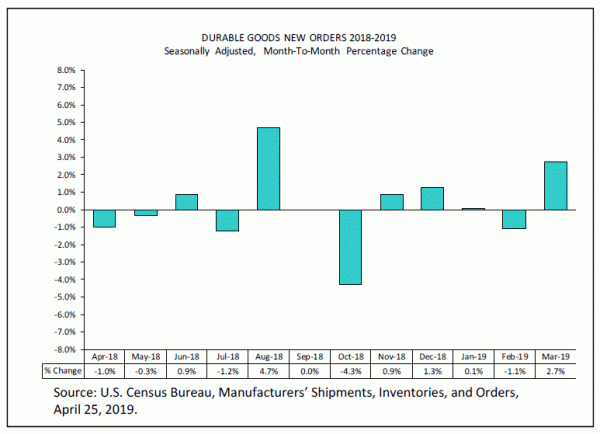

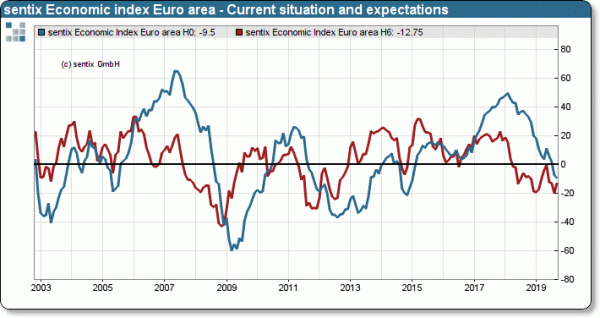
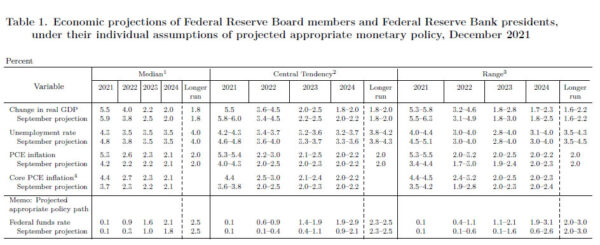
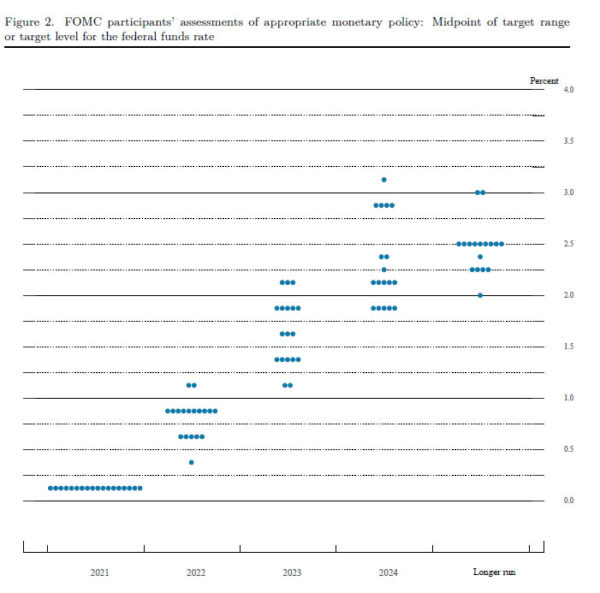
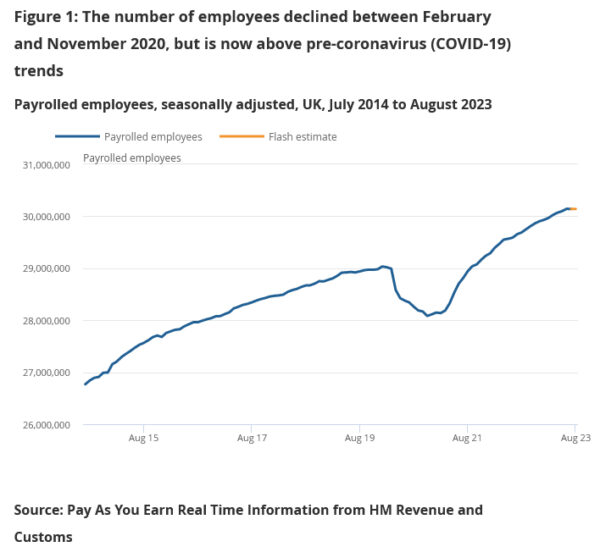
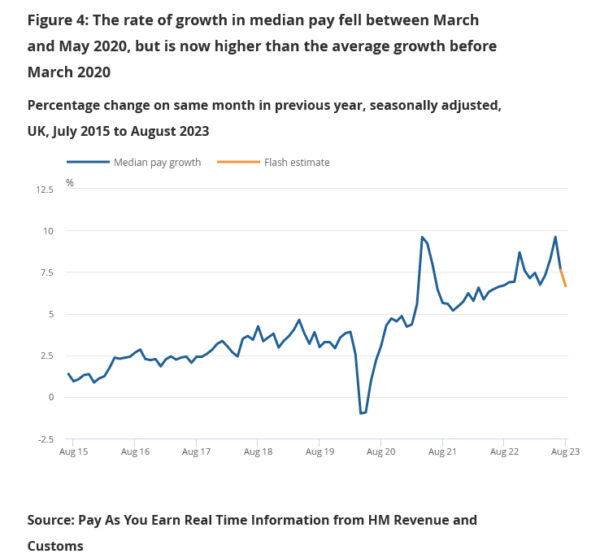
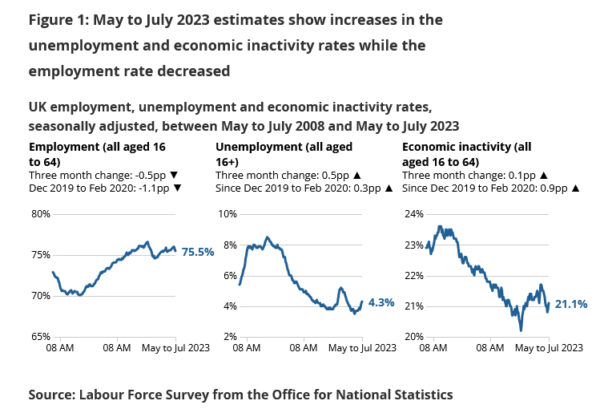
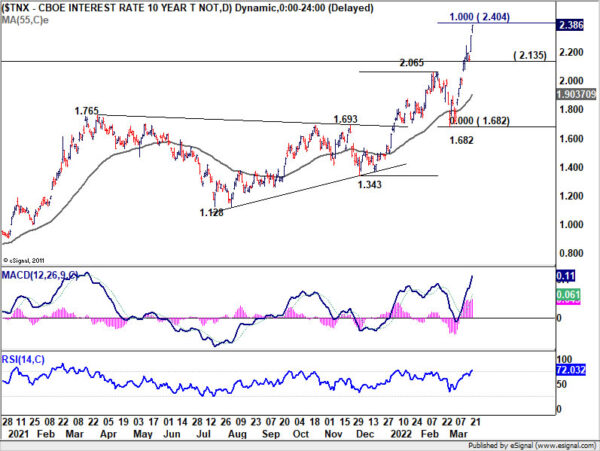
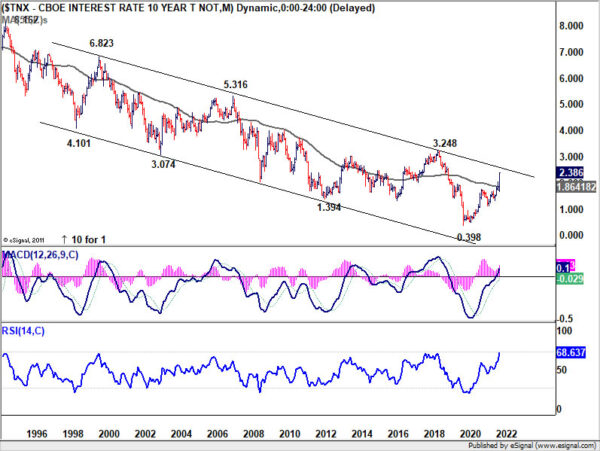

SECO lowers Swiss 2019 growth and inflation forecasts significantly
The State Secretariat for Economic Affairs (SECO) lowered both 2018 and 2019 Swiss growth forecasts significantly. SECO cited that “this is mainly due to weak domestic demand”. Also, “In the wake of the decline in international growth, Swiss foreign trade decreased. The appreciation of the Swiss franc in the meantime additionally slowed exports, while domestic demand also failed to stimulate growth. ”
On inflation
On more thing to now is that SECO’s projection was based on assumption that the three month LIBOR interest rate will climb to -0.5% in 2020.
Full release here.